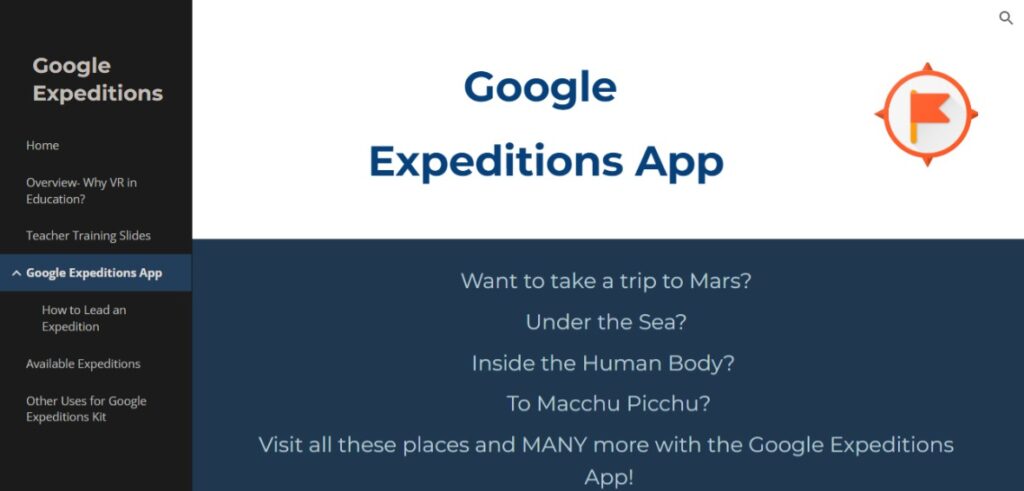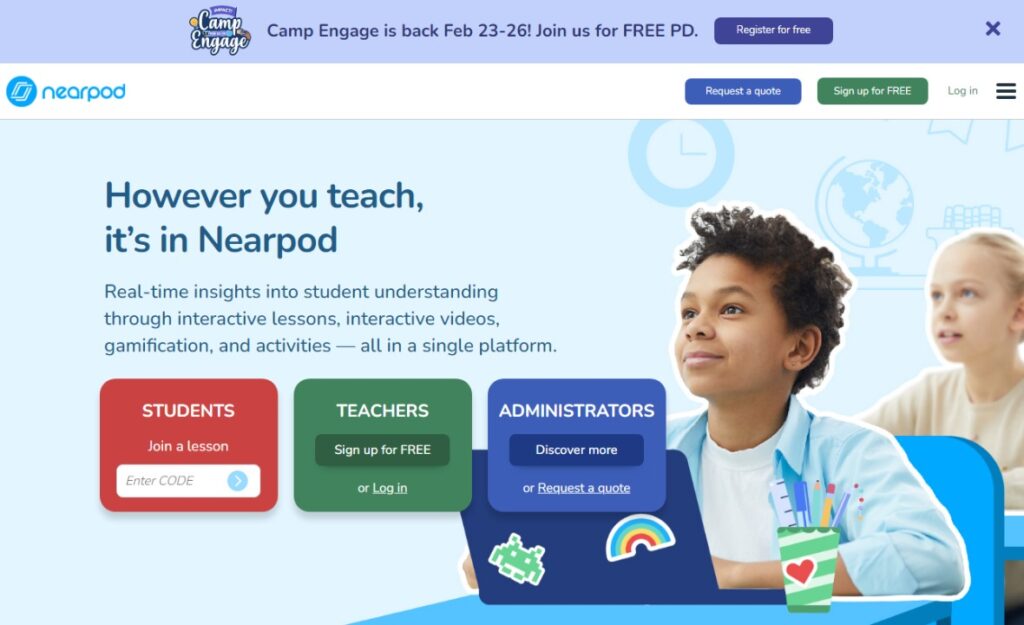As technology evolves, the traditional mode of learning where a teacher or lecturer tutors a class full of students or employees is gradually becoming outdated. Now, schools and companies are exploring newer and better ways to facilitate learning and skill development.
One of the methods they’re exploring is immersive learning. This learning method involves using state-of-the-art technology to significantly improve education and create a unique learning experience for students.
In this piece, we’ll delve into what immersive learning is, the types of technology used for it, the benefits of immersive learning in schools and workplaces, and some real-life examples of this learning method in action.
Skip ahead:
- What is immersive learning?
- Types of immersive learning technology
- What are the benefits of immersive learning?
- Examples of immersive learning
- How to create an immersive learning environment
What is immersive learning?
Immersive learning is an experiential training process that uses high technology to simulate real-world scenarios and help students learn new skills. This learning method combines the feeling of presence virtual reality (VR) provides with data science, advanced learning theory, and spatial design to improve user engagement and encourage the assimilation of information.
During immersive learning sessions, students use 2D desktop devices or XR headsets to enter a virtual environment that comprises simulated versions of elements and concepts from the physical world. This includes virtual tools to virtual avatars that represent people. The entire experience is usually gamified with features like 3D graphics, game mechanics, and scoring, which makes it more engaging.
No matter the topic or learning goal, learning designers are able to create suitable virtual environments for learning to take place without the barriers that may exist if they tried to recreate those environments in the real world.
Because immersive technologies blur the lines between what’s real and what isn’t, learners aren’t passive spectators — as they are in classrooms. Instead, they become active participants who engage with simulated concepts and directly influence outcomes. Even better, learners get to develop their skills in a safe space where success can be measured accurately.
Types of immersive learning technology
The first step to embracing immersive learning in schools, workplaces, and informal settings like museums or tours is to know the different types of technologies that are used to create these experiences. Below are the four major types of technologies that make immersive learning possible.
Virtual Reality
Virtual reality, or VR, is a digital experience created by software engineers that allow a person to be fully immersed in an environment that replicates, but is separate from, the physical world. This experience can be created for educational or entertainment purposes.
Users can gain access to these environments through VR headsets, such as HTC Vive, Google Daydream View, or Oculus Rift. These headsets have headphones and hand controllers that help the user navigate the virtual space. This means that the user can walk/run around a room or street, move and pick up objects, interact with virtual characters, and assemble and take things apart.
The most common use case for virtual reality is video games, but it can also be used for education and business purposes.
Augmented Reality
Unlike virtual reality, augmented reality (AR) doesn’t block out the real world. Instead, it blends with it by placing virtual objects in real spaces. These digital objects can take many shapes; it can be a two-dimensional shape, which works well for instructional information, or a three-dimensional shape, which is great for practical observation.
AR glasses (like Raptor AR headset) or other AR-capable devices illustrate digital concepts and principles in the real world and allow the user to fully explore the object and learn more about it. It’s like adding virtual layers over real-world elements through a lens. This means that AR isn’t fully immersive as users can tell apart real details from digital ones.
You’re likely more familiar with augmented reality than you think. If you’ve ever tried using Snapchat or TikTok filters over your selfies or videos, you’ll notice that the filter overlays over the image, whether it’s a funny pair of rabbit ears or a different image granularity. It’s the same when you play Pokemon Go and the Pokemon you catch is superimposed over your real-life location.
Mixed reality
Mixed reality, or MR, combines elements of virtual and augmented reality to create an environment where digital and real items can co-occur and interact in real-time. Just like augmented reality, MR superimposes digital elements over the physical world and allows them to interact with real-world objects. The difference between MR and AR, though, is that in mixed reality, real objects can obscure digital elements.
Think of mixed reality as a super-charged version of augmented reality. While augmented reality allows people to see virtual objects in the real world, mixed reality allows users to actually manipulate those virtual objects. A great example of MR technology is Microsoft HoloLens, which is a head-mounted display (HMD) that creates holographs of people, objects, or places, and allows users to interact with those objects.
360° film
360° film is the most familiar type of immersive technology that exists today. That’s because it presents as a video that people film, rather than something that is computer-generated. You can find 360° content anywhere online, especially on platforms like YouTube, Facebook, and Twitter. In fact, most modern smartphones allow users to create 360° images and videos themselves.
While people can access and be immersed in 360° videos through a VR headset, they are limited to the filmmaker’s point of view. This means that, while a user can see the world around them, they’re unable to interact with their surroundings. In schools, teachers use 360° videos to take their students on field trips and tours without ever leaving the classroom. The same goes for businesses that want to teach their employees how to use certain expensive or dangerous equipment without running the risk of damage or injury.
What are the benefits of immersive learning?
In 2020, Talespin partnered with PricewaterhouseCoopers (PwC) on a study of the effects of virtual reality in the workplace. Here are some of the findings they made:
- VR-trained employees were 4x more focused during training than classroom learners and e-learners.
- Employees who learned through virtual reality felt a stronger emotional connection to the content which was 3.75x more than classroom learners and 2.3x more than e-learners.
- VR learners finished their training 4x faster than classroom learners, and 1.5x times faster than e-learners.
- VR learners were 275% more confident to put their learnings into action — which is a 40% improvement over classroom learners, and a 35% improvement over e-learners.
- When the number of learners was considered, VR training cost significantly less than classroom learning and e-learning.
These stats show you the benefits of immersive learning in the workplace. Now let’s examine, in more detail, just how beneficial immersive learning can be in whatever setting it is used.
Immersive learning makes for more engaging education
In her book, Tools for Teaching, Barbara Gross Davis postulates that student attention during lectures wanes after 10-15 minutes. Other respected scholars such as Phillip C. Wankat and Ludy T. Benjamin also noticed this.
Given that lectures and training sessions take considerably longer than 15 minutes, it is imperative that teachers employ learning methods that will keep their students’ attention. Immersive learning is one such learning method.
Because students are able to see and interact with virtual elements that replicate real-life objects, immersive learning is more engaging than classroom lessons. With the help of VR, AR, or MR technologies, students feel like they’re right in the center of the action. Most, if not all, of their senses are activated, thus increasing how well they understand what they’re being taught.
For example, instead of trying to describe to students what happened during the Ming Dynasty in the 14-17th century, teachers could use immersive learning to virtually transport students through a simulation of Ancient China during that time. Or if a science teacher is trying to explain the contents of a cell to their students, they could use virtual reality to help students explore the inside of a cell.
Even better, teachers can use VR to introduce gaming-like elements into their classes to make them more fun and engaging. For example, students who are learning landscaping or city development could use VR headsets to build virtual cities. Medical students could operate on virtual patients and score points if they complete the operation successfully and within the pre-set time limit.
The appeal of immersive learning is that it can be whatever the teacher wants it to be. So, as far as engagement goes, immersive technology can ramp things up and get students much more interested in their studies.
Immersive learning promotes hands-on education
Tactile learners are people who assimilate information better when they practice. Instead of sitting in a chair and listening to a teacher explain a topic, they prefer to try things out in a lab or work on a group project. Immersive learning is a great method to help these students understand practical topics.
In their paper for Frontier for Young Minds, researchers Rebecca E. Penn and Michael C. Hout talked about how virtual reality tricks people’s brains to react to immersive experiences the same way they would to things happening in the real world. This makes immersive learning a viable method for practice-based education. Students can experiment, explore, and discover new things. And when they’re about to take exams, they can draw on their memories of those experiences to ace their tests.
Immersive learning provides a distraction-free learning environment
With the invention of smartphones, the Internet, and social media platforms, there’s a lot of online noise that is almost impossible to ignore. In a traditional classroom setting, students have to deal with environmental distractions, noise from other students, messages, social media notifications, and more. All of this negatively impact students’ ability to retain information.
Immersive learning gets rid of these distractions by blocking out the real world. This, however, is unique to virtual reality. But although augmented and mixed reality superimpose virtual objects over real spaces, the focus is on the virtual objects, so distractions are at a minimal level.
Immersive learning creates a safe learning environment
There are certain skills that, in the real world, carry a high level of risk to people and to the equipment used during training. In situations like this, immersive learning can reduce the risk level to zero.
Police departments and the FBI use immersive learning technology to carry out tactical training for law enforcement personnel. They use VR headsets to simulate critical situations where agents and police officers have to use their guns, de-escalate violence, and/or arrest criminals. Similarly, the Federal Aviation Administration spends millions of dollars to acquire simulators to train air traffic control specialists on what to do in negative situations like bad weather and an impending crash.
Enacting these scenarios with real-life criminals or airplanes carries risks of injury, property damage, and even death. But using immersive technology eliminates these risks completely.
Safety isn’t limited to just physically dangerous situations though. It also takes precedence during soft skills training. With immersive learning, employees can practice speaking with customers and managing crises without the risk of losing customers or denting stakeholder relationships should they do something wrong.
Immersive technology is cost-effective
The cost of acquiring the technology you need to implement immersive learning can be high. However, if you’re going to be training large numbers of people each year, it can help you save money down the road.
In their 2022 paper for Educational Research Review, Yuk Ming Tang and other researchers described how engineers developed a low-cost virtual reality surgical simulation to teach surgical oncology residents how to perform certain operations and provide care to patients. The technology itself was low-cost from the jump, but the value increases when you compare it to the cost of buying real surgical equipment and getting cadavers to conduct experimental operations on.
In cases where the simulators are more expensive than getting real-life equipment, it’s still much better to get the simulators. The cost of paying staff to maintain real-life equipment and getting new equipment when old ones get damaged can rack up immensely over time. With simulators, it’s the opposite. Thousands of people can use the same set of simulators for years without any damage — provided the technology is used correctly and maintained properly.
Examples of immersive learning
To show you how immersive learning works in the real world, here are some examples of schools and companies using immersive technology to teach students and train staff.

Walmart uses virtual reality to teach employees good customer service and how to respond to angry shoppers when they swarm their stores during Black Friday. The technology is also used to determine if employees have the skill necessary to work in middle management positions.
Since they started using VR in their training sessions, Walmart has seen improvements in employee test scores and now, they can introduce new training programs with the confidence that employees will take to them like fish to water.
“When we used the Oculus Rift VR headset in the classroom, we noticed an increase in test scores between 5 percent and 10 percent,” said Andy Trainor, the Vice President of Learning at Walmart during an interview. “We are starting to replace some global learning management system modules that can take 30 to 45 minutes and transitioning this to a three- to five-minute module in the virtual reality environment.”

The Google Expeditions app uses virtual reality to help students experience different parts of the world. It combines it with Augmented Reality technology that helps students grasp some concepts that are hard to explain or illustrate on paper.
In the Google Expeditions Pioneer Program, several teams from Google visit schools and universities around the world with the Expeditions Kit. The teams give school teachers comprehensive training on how to use virtual reality to teach their students.
Once the systems are set up, teachers will be able to take their students on field trips to any country or landmark, as the options offered in the program are endless. While teachers are students are seeing and hearing the same things, the teacher will be able to discuss things as they go along. So the experience is similar to a classroom, but one conducted in a virtual space.

Nearpod is a company that seamlessly combines VR and AR technology to create a more immersive and engaging classroom environment. However, instead of completely abandoning traditional learning methods, Nearpod helps teachers use integrated 360° imagery and videos to improve lesson quality for both classroom and e-learners.
Speaking about how Nearpod improved the quality of education at his school, school counselor James Funkhouser says, “Instead of talking to [students] about careers, I could put them in the middle of the action. They could stand in the middle of an operating room, stare down the arm of a crane, or immerse themselves in a NASA space station.
“The possibilities seemed endless. Not only could I take students to careers, but I could provide them with virtual tours of colleges and universities. [Students] instantly noticed the size, scope, and design of the spaces. Their questions poured out from programming to student life. Instantly, we were having deep meaningful conversations about college in third grade. I was blown away.”
How to create an immersive learning environment
If you’re a teacher or school consultant who is considering trying out immersive learning technologies, here are some steps you should take to create a good immersive learning environment.
Choose the right technology
Each kind of immersive learning technology comes with its upsides and downsides. So to create a good immersive learning environment, choose the right technology based on the topic you’re teaching, the kind of people you’re teaching, and your budget. For example, if you want to show your students what Jupiter’s surface looks like, virtual reality would work better than augmented or mixed reality.
You should also think about whether you want it to be a shared experience or not, how much physical space and time you have, and the age group of your students. If you’re teaching children that need adults to accompany them in the real world, it might be dangerous to put them in a fully immersive virtual reality space.
Plan your lessons in advance
If you’re transitioning from classroom learning to immersive learning, know that you need to plan your immersive learning sessions differently. While classroom lectures can take an hour per subject, immersive sessions should last for a maximum of 30 minutes. When you take into consideration the average attention span of learners (10-15 minutes), you’ll realize that immersive experiences are far more effective at promoting engagement and focus when they are bite-sized.
To ensure that you can fit the important aspects of your lessons into a half-hour session, you may need to storyboard different scenarios and actions. If you’ll be explaining certain things during the lesson, you may want to whip up a rough draft/script of what you plan to talk about. This helps you keep to the time and deliver a valuable session.
Onboard your students properly
Immersive learning technologies are fun and engaging, but they can be overwhelming for new users. So before you start immersive lessons, ensure that you give your students clear instructions on how the tools work, what to expect during the experience, how they should conduct themselves during the lesson, and how to leave an experience if they feel any discomfort.
You could also create an avatar to serve as a guide and help the learners navigate the digital space.
Use simulations
If you’re teaching students to develop and apply certain skills, simulations are a great way to help them. In fact, simulations have been used to teach skills for centuries, going as far back as 18th century France when Angelique Marguerite le Boursier du Coudray used a cloth birthing simulator to teach birthing techniques to midwives and surgeons. Pilots spend thousands of hours practicing with simulations before entering an actual plane cockpit.
Today, we have advanced technology that allows people in all industries to master their skills before applying them in the real world. However, these technologies are best used in industries where the accuracy of skill application is a matter of life and death or where errors could be costly. Examples of these industries include the automotive manufacturing, aviation, construction, healthcare, and pharmaceutical manufacturing industries.
Gamify your lessons
A great way to make lessons engaging and encourage retention in learners is to offer gamified learning modules. This is especially important if you’re teaching Gen Z’ers (18-23 years) because they are used to playing games on their smartphones, laptops and computers. You can either make the lesson itself a game with increasingly difficult levels or you can add gaming elements like points, scoreboards, and awards. This motivates learners to study more (to gain more points) and encourages healthy competition among students.
Just like simulations, games create a world where learners have to perform certain tasks by following pre-set rules. When they follow these rules to the ‘T’, they gain rewards — and when they don’t, they fail. This helps them understand the concept of consequences should they fail to apply skills correctly.
Take your class to the next level with immersive learning
Immersive learning is a wonderful way for people of all ages to gain new skills and increase their knowledge. The advancement of technology in recent years have made VR headsets and mobile technology more affordable and functional. Now, educators can exploit the power of immersive learning to teach students in a manner that is engaging and impactful.






